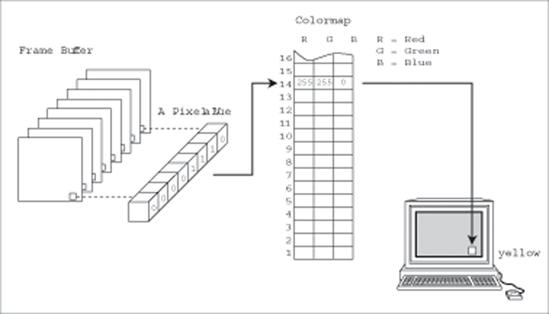2.3 Introduction to X Graphics
This section provides a brief introduction to the terms and concepts used in graphics under the X Window System. You will see these terms used in Chapter 3 and Chapter 4 before we get to a serious treatment of graphics in Chapter 5, Chapter 6, and Chapter 7.
2.3.1 Pixels and Colors
The X Window System is designed to control bitmapped graphics displays. In the simplest black-and-white display, there is a single bit per pixel: the state of that bit determines whether the pixel will be black or white. In color systems or on monochrome systems allowing gray-scale displays, there are multiple bits per pixel.
The state of the multiple bits assigned to each pixel does not directly control the color or gray-scale intensity of that pixel. Instead they are used as an index to a lookup table called a colormap, as shown in Figure 2-8. On a color display, a pixel consists of separate red, green, and blue phosphors, each sensitive to a separate electron beam; the relative intensity of these three colors fools the eye into thinking it sees a single color. Accordingly, the colormap contains an array of red, green, and blue (RGB) triples. In other words, if the value of the bits for a given pixel (a pixel value) is 14, the RGB values of the fourteenth member of the colormap will be displayed at that location on the screen.

Figure 2-8. Mapping of pixel value into color through ...
Get XLIB Programming Manual, Rel. 5, Third Edition now with the O’Reilly learning platform.
O’Reilly members experience books, live events, courses curated by job role, and more from O’Reilly and nearly 200 top publishers.

